Go语言设计模式之责任链模式
2023-07-29
其实很多人不知道,责任链模式是我们工作中经常遇到的模式,特别是web后端工程师,我们工作中每时每刻都在用:因为市面上大部分的web框架的过滤器基本都是基于这个设计模式为基本模式搭建的。
1.模式介绍
我们先来看一下责任链模式(Chain Of Responsibility Design Pattern )的英文介绍:
Avoid coupling the sender of a request to its receiver by giving more than one object a chance to handle the request. Chain the receiving objects and pass the request along the chain until an object handles it.
翻译成中文就是:将请求的发送和接收解耦,让多个接收对象都有机会处理这个请求。将这些接收对象串成一条链,并沿着这条链传递这个请求,直到链上的某个接收对象能够处理它为止。
这么说比较抽象,用更加容易理解的话来进一步解读一下。在责任链模式中,一个请求过来,会有多个处理器(也就是刚刚定义中说的“接收对象”)依次处理同一个请求。即请求先经过 A 处理器处理,然后再把请求传递给 B 处理器,B 处理器处理完后再传递给 C 处理器,以此类推,形成一个链条。链条上的每个处理器各自承担各自的处理职责,所以叫作责任链模式。

2.模式demo
2.1UML
责任链模式(Chain Of Responsibility Design Pattern )的整体结构如下:
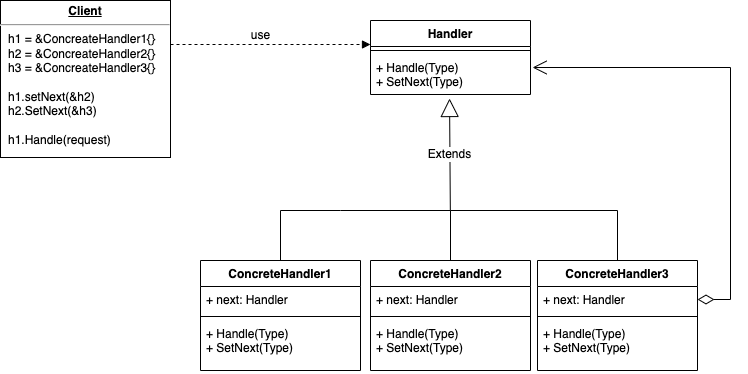
2.2 标准demo
我们依据标准的UML图,写出一个具体的例子(对应UML图):
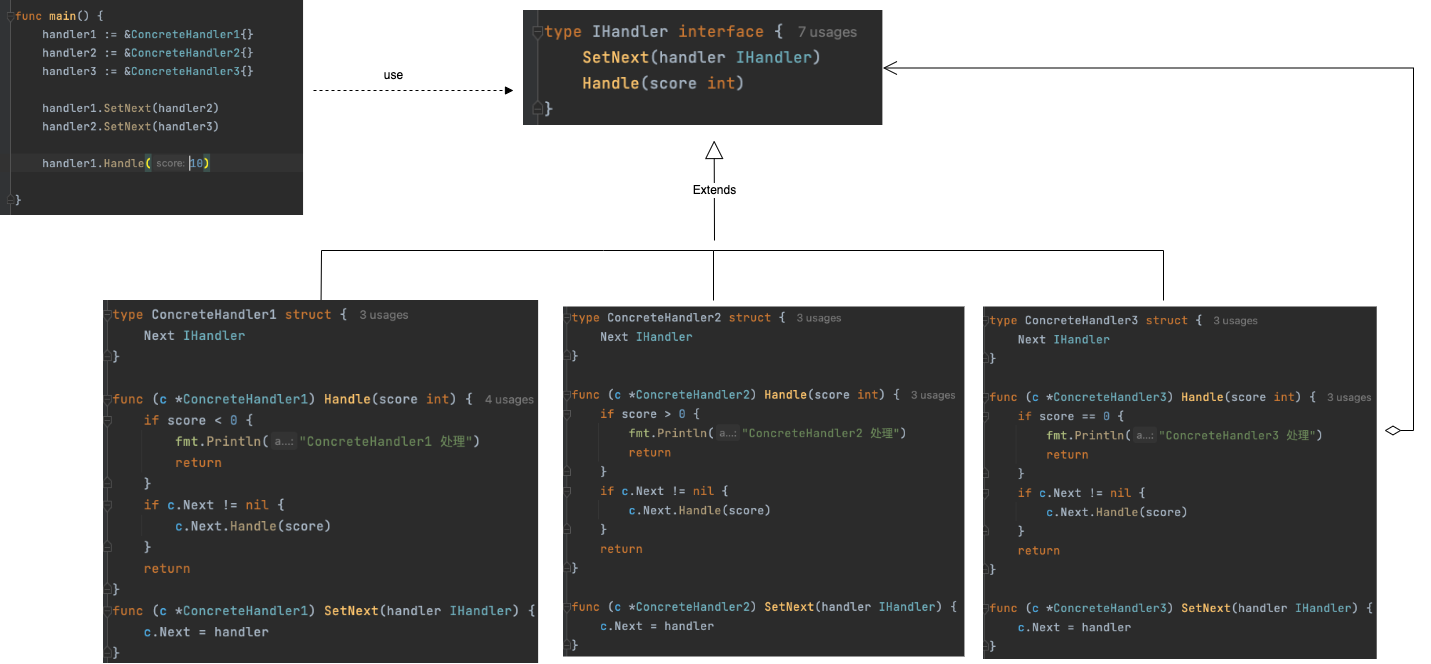
首先定义一个接口IHandler:
type IHandler interface {
SetNext(handler IHandler)
Handle(score int)
}然后分别构建三个不同的实现:ConcreteHandler1
type ConcreteHandler1 struct {
Next IHandler
}
func (c *ConcreteHandler1) Handle(score int) {
if score < 0 {
fmt.Println("ConcreteHandler1 处理")
return
}
if c.Next != nil {
c.Next.Handle(score)
}
return
}
func (c *ConcreteHandler1) SetNext(handler IHandler) {
c.Next = handler
}ConcreteHandler2
type ConcreteHandler2 struct {
Next IHandler
}
func (c *ConcreteHandler2) Handle(score int) {
if score > 0 {
fmt.Println("ConcreteHandler2 处理")
return
}
if c.Next != nil {
c.Next.Handle(score)
}
return
}
func (c *ConcreteHandler2) SetNext(handler IHandler) {
c.Next = handler
}ConcreteHandler3
type ConcreteHandler3 struct {
Next IHandler
}
func (c *ConcreteHandler3) Handle(score int) {
if score == 0 {
fmt.Println("ConcreteHandler3 处理")
return
}
if c.Next != nil {
c.Next.Handle(score)
}
return
}
func (c *ConcreteHandler3) SetNext(handler IHandler) {
c.Next = handler
}最后是main函数:
func main() {
handler1 := &ConcreteHandler1{}
handler2 := &ConcreteHandler2{}
handler3 := &ConcreteHandler3{}
handler1.SetNext(handler2)
handler2.SetNext(handler3)
handler1.Handle(10)
}打印结果为:
1 | ConcreteHandler2 处理 |
2.3 改进版demo
通过以上标准例子不难发现:main函数承接了很多client自身之外的“额外工作”:构建和拼接组装责任链,这不利于后续client端的使用和扩展:一不小心可能责任链拼就接错了或者拼接少节点了。
我们可以对UML做一个改进:增加一个节点管理模块。改进图如下:
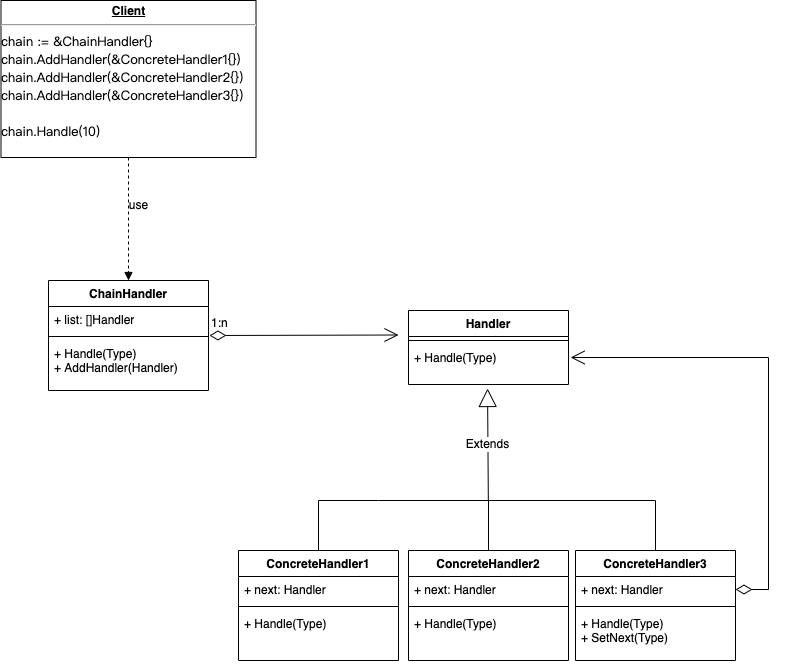
对比上文的uml图,新增加了一个ChainHandler结构体用来管理拼接的Handler,client端无需了解Handler的业务,Handler的组合可以使用链表,也可以使用数组(当前用了数组)。
具体实现如下:
先定义Handler接口:
type Handler interface {
Handle(score int)
}然后分别实现Handler接口的三个结构体:ConcreteHandlerOne
type ConcreteHandlerOne struct {
Handler
}
func (c *ConcreteHandlerOne) Handle(score int) {
if score < 0 {
fmt.Println("ConcreteHandler1 处理")
return
}
}ConcreteHandlerTwo
type ConcreteHandlerTwo struct {
Handler
}
func (c *ConcreteHandlerTwo) Handle(score int) {
if score > 0 {
fmt.Println("ConcreteHandler2 处理")
return
}
}ConcreteHandlerThree
type ConcreteHandlerThree struct {
Handler
}
func (c *ConcreteHandlerThree) Handle(score int) {
if score == 0 {
fmt.Println("ConcreteHandler3 处理")
return
}
}main函数调用(client调用):
func main() {
chain := &ChainHandler{}
chain.AddHandler(&ConcreteHandlerOne{})
chain.AddHandler(&ConcreteHandlerTwo{})
chain.AddHandler(&ConcreteHandlerThree{})
chain.Handle(10)
}最终的实现结构图:
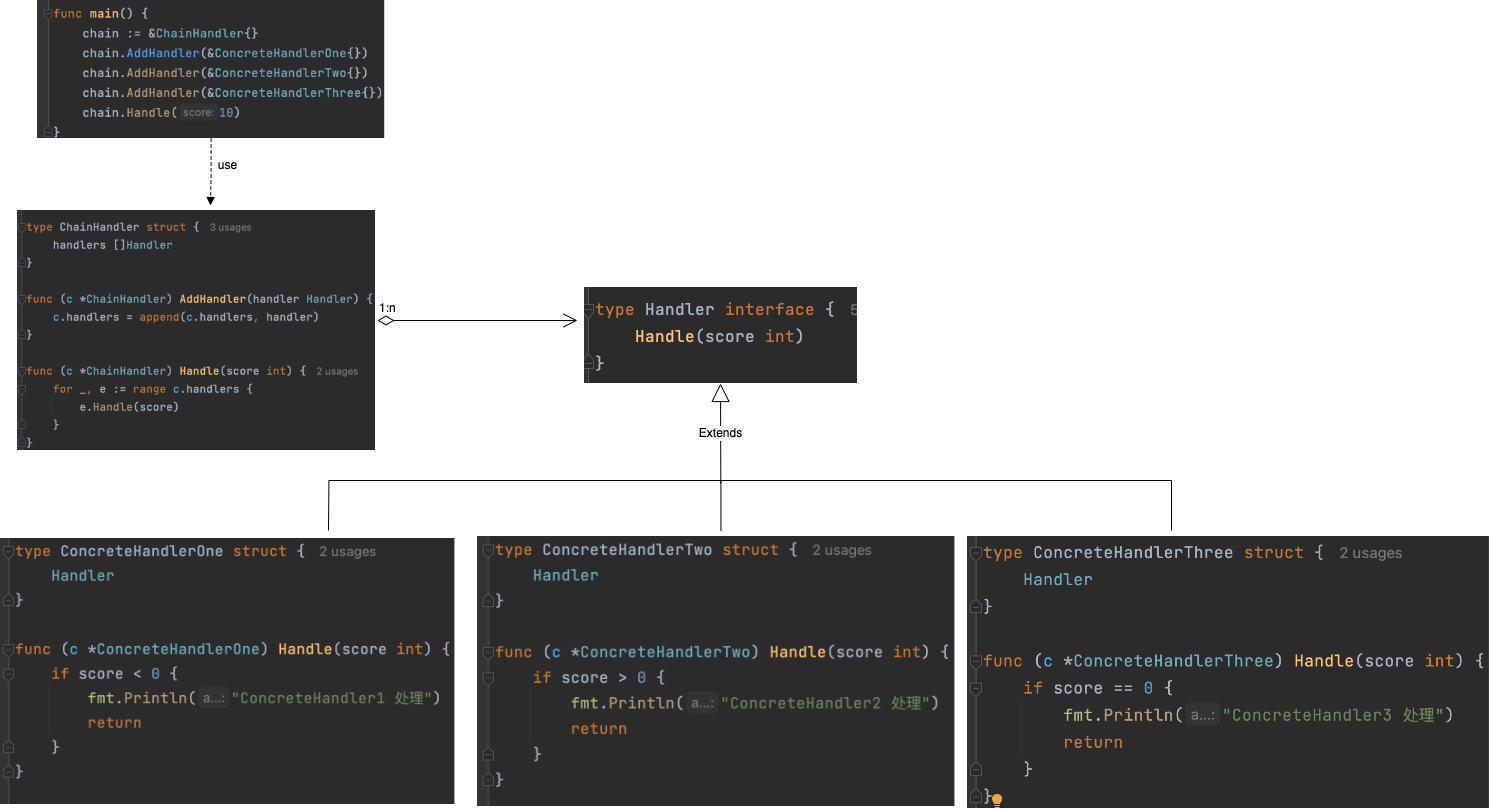
日常工作中出现的责任链模式(Chain Of Responsibility Design Pattern )一般都是以上这种包含Hanlder管理的模式。
3. 源码解析
在日常框架和语言基础库中,经常能够看到很多场景使用了责任链模式。
3.1 beego过滤器
可以对比改进版demo的uml图,beego的过滤器就是按照这种模式来设计的(当前参照的beego版本是2.0)。
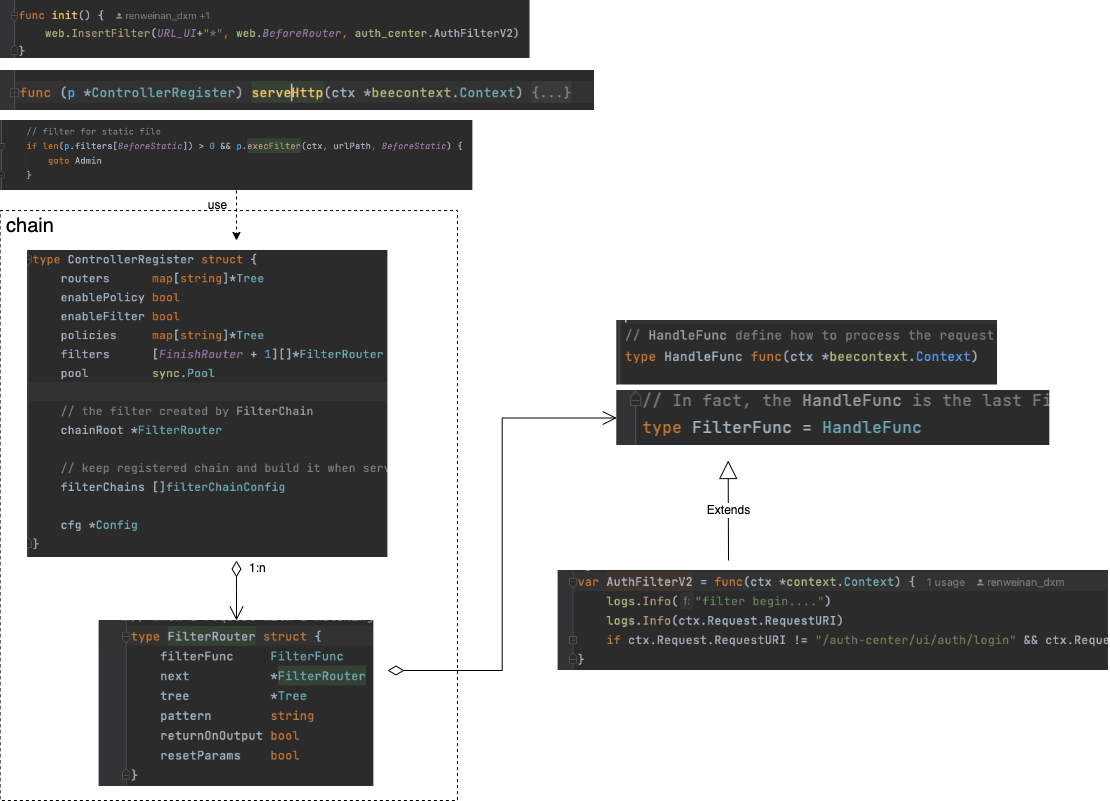
3.1.1 client端
调用端首先是过滤器的注册:
web.InsertFilter("/v2/api/*", web.BeforeRouter, auth.AuthAPIFilter)然后在github.com/beego/beego/v2@v2.0.3/server/web/router.go的ControllerRegister结构体的serveHttp函数中
1 | if len(p.filters[BeforeRouter]) > 0 && p.execFilter(ctx, urlPath, BeforeRouter) { |
以上p.execFilter(ctx, urlPath, BeforeRouter)处,启动调用。
3.1.2 Handler接口
Handler接口很简单
// HandleFunc define how to process the request
type HandleFunc func(ctx *beecontext.Context)
...
type FilterFunc = HandleFunc3.1.3 Handler接口实现
接口的实现扩展比较灵活,直接把用户定义的函数作为接口的实现。与client端中的过滤器注册联动。
// 过滤器注册
web.InsertFilter("/v2/api/*", web.BeforeRouter, auth.AuthAPIFilter)
// 自定义过滤器
var AuthAPIFilter = func(ctx *context.Context) {
isAccess := validateAccess(ctx)
if !isAccess {
res, _ := json.Marshal(r)
ctx.WriteString(string(res))
// ctx.Redirect(401, "/401")
}
}3.1.4 Handler管理
Handler的管理模块是在github.com/beego/beego/v2@v2.0.3/server/web/router.go的中的 FilterRouter和ControllerRegister两个结构体中
// ControllerRegister containers registered router rules, controller handlers and filters.
type ControllerRegister struct {
routers map[string]*Tree
enablePolicy bool
enableFilter bool
policies map[string]*Tree
filters [FinishRouter + 1][]*FilterRouter
pool sync.Pool
// the filter created by FilterChain
chainRoot *FilterRouter
// keep registered chain and build it when serve http
filterChains []filterChainConfig
cfg *Config
}
type FilterRouter struct {
filterFunc FilterFunc
next *FilterRouter
tree *Tree
pattern string
returnOnOutput bool
resetParams bool
}FilterRouter是一个链表,包含用户自定义的过滤函数;ControllerRegister对FilterRouter进行管理。
3.2 Go源码http.handler
我们在使用Go构建http web服务器的时候,使用的http.Handler就是使用的责任链模式。
package main
import (
"net/http"
)
func main() {
s := http.NewServeMux()
s.HandleFunc("/", func(writer http.ResponseWriter, request *http.Request) {
// todo ....
return
})
http.ListenAndServe(":80", s)
}以2.3 的UML图为标准,整体的结构图如下:

3.2.1 client端
整个模式的启动是随着http server启动后,接受到请求后的处理开始的。在net/http/server.go的serve函数中
func (c *conn) serve(ctx context.Context) {
...
// HTTP cannot have multiple simultaneous active requests.[*]
// Until the server replies to this request, it can't read another,
// so we might as well run the handler in this goroutine.
// [*] Not strictly true: HTTP pipelining. We could let them all process
// in parallel even if their responses need to be serialized.
// But we're not going to implement HTTP pipelining because it
// was never deployed in the wild and the answer is HTTP/2.
serverHandler{c.server}.ServeHTTP(w, w.req)
...
}可以看到http server的原理很简单,就是for 死循环等待接收,然后一个请求过来,就对应的生成一个单独的协程goroutine去处理。
3.2.2 Handler接口
Go源码中对责任链模式的实现非常标准,Handler接口与设计模式中的Handler接口同名,在net/http/server.go中:
type Handler interface {
ServeHTTP(ResponseWriter, *Request)
}为了扩展方便,在使用过程中并非直接使用,而是中间又加了一层抽象层(相当于Java中的抽象类了,Go中没有抽象类)
// The HandlerFunc type is an adapter to allow the use of
// ordinary functions as HTTP handlers. If f is a function
// with the appropriate signature, HandlerFunc(f) is a
// Handler that calls f.
type HandlerFunc func(ResponseWriter, *Request)
// ServeHTTP calls f(w, r).
func (f HandlerFunc) ServeHTTP(w ResponseWriter, r *Request) {
f(w, r)
}3.2.3 Handler接口实现
与上文中提到的Beego的过滤器类似,Go的Handler设计的也非常容易扩展,用户自定义的请求处理函数Handler都会变成Handler的子类。
func main() {
s := http.NewServeMux()
s.HandleFunc("/", func(writer http.ResponseWriter, request *http.Request) {
// todo ....
return
})
http.ListenAndServe(":80", s)
}
// HandleFunc registers the handler function for the given pattern.
func (mux *ServeMux) HandleFunc(pattern string, handler func(ResponseWriter, *Request)) {
if handler == nil {
panic("http: nil handler")
}
// 强制类型转换,转成了实现了Hanlder的“抽象类”HandlerFunc
mux.Handle(pattern, HandlerFunc(handler))
}注意看上文的HandleFunc中的 mux.Handle(pattern, HandlerFunc(handler))这一行,将用户自定义的处理函数强制转换成了上文3.2.2中的Handler的”抽象类”HandlerFunc类型,进而实现了继承。
3.2.4 Handler接口的管理类ChainHandler
Go中对Handler的管理类是在net/http/server.go文件的ServeMux结构体和muxEntry结构体中:
type ServeMux struct {
mu sync.RWMutex
m map[string]muxEntry
es []muxEntry // slice of entries sorted from longest to shortest.
hosts bool // whether any patterns contain hostnames
}
type muxEntry struct {
h Handler
pattern string
}其中,用户自定以的处理函数都被封装到了muxEntry结构体的Handler中,一个自定义的函数对应一个muxEntry,ServeMux使用hashmap对muxEntry集合进行管理(上文的beego中是使用的链表,上文demo中使用了数组)。当web server接收到请求的时候,ServeMux会根据hashmap找到相应的handler然后处理。
func (mux *ServeMux) ServeHTTP(w ResponseWriter, r *Request) {
if r.RequestURI == "*" {
if r.ProtoAtLeast(1, 1) {
w.Header().Set("Connection", "close")
}
w.WriteHeader(StatusBadRequest)
return
}
// *******寻找handler*******
h, _ := mux.Handler(r)
h.ServeHTTP(w, r)
}
func (mux *ServeMux) Handler(r *Request) (h Handler, pattern string) {
...
if path != r.URL.Path {
_, pattern = mux.handler(host, path)
u := &url.URL{Path: path, RawQuery: r.URL.RawQuery}
return RedirectHandler(u.String(), StatusMovedPermanently), pattern
}
// *******寻找handler*******
return mux.handler(host, r.URL.Path)
}
func (mux *ServeMux) handler(host, path string) (h Handler, pattern string) {
mux.mu.RLock()
defer mux.mu.RUnlock()
// Host-specific pattern takes precedence over generic ones
if mux.hosts {
// *******寻找handler*******
h, pattern = mux.match(host + path)
}
if h == nil {
// *******寻找handler*******
h, pattern = mux.match(path)
}
if h == nil {
h, pattern = NotFoundHandler(), ""
}
return
}
func (mux *ServeMux) match(path string) (h Handler, pattern string) {
// ********通过hashmap找到相关handler*********
v, ok := mux.m[path]
if ok {
return v.h, v.pattern
}
for _, e := range mux.es {
if strings.HasPrefix(path, e.pattern) {
return e.h, e.pattern
}
}
return nil, ""
}在程序运行过程中,用户注册自定义的函数被转化成了Handler,然后Handler又结合用户自定义的URL地址被ServeMux以URL为Key、Handler为Value做成hashmap管理起来;等到请求来的时候,ServeMux就根据用户请求的URL地址,从hashmap中找到具体的Hanlder来处理请求。
4. 总结
责任链模式的基本思想就是要处理的请求(通常会是结构体,然后作为函数参数);依次经过多个处理对象处理,这些处理函数可以动态的添加和删除,具备很高的灵活性和扩展性,通常会对这些处理函数做统一处理,存储方式一般是通过链表、数组、hash map等存储结构。
责任链模式的应用非常广泛:
- 业务场景:作为敏感词(涉黄、政治、反动等此)过滤的设计结构
- 技术框架:路由、router过滤器、日志log框架等等
